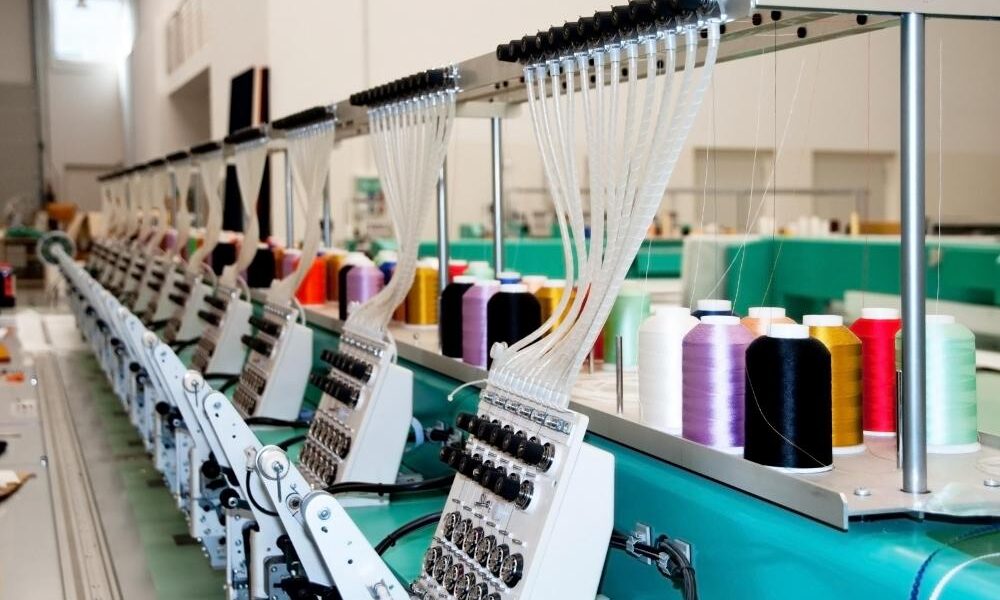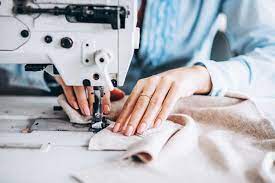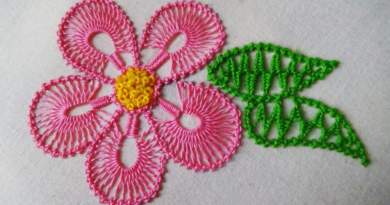Free Embroidery Machine Operator Course(1year Diploma)
Embroidery Machine Operator click here
Brief Job Description:- An Embroidery Machine Operator is responsible for operating the embroidery machine to embroider decorative designs on fabric/garments in the apparel industry. The embroidery machine operator is able to perform different kinds of stitches and decorative work such as running shade work, cording & satin stitch, eyelet work, applique work, shade work and round, cut work and open work, pin stitch & pitch stitch, china embroidery & fancy embroidery.
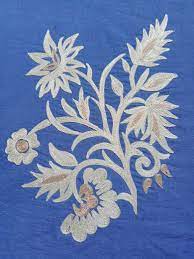
Personal Attributes: -An embroidery machine operator should have good eyesight, eye-hand-leg coordination, motor skills and vision (including near vision, distance vision, colour vision, peripheral vision, depth perception and ability to change focus) Embroidery Machine Operator Course.

Prepare for ZigZag Machine Embroidery Machine Operator Course:-
To be competent, you must be able to:
PC1. Analyze& interpret the given design which needs to be embroidered & the type of embroidery that is required to be done
PC2. Check the materials required for embroidery with the given specifications
PC3. Setup the embroidery machine to the suited setting for carrying out the embroidery to be done
Carry out different Types of Embroidery Stitches & Artwork:-
PC4. Use the embroidery machine to carry out dotted stitch on given fabric / material
PC5. Operate the embroidery machine to embroider different designs as per given pattern/art work such as variations of round leafs & pointed leafs Embroidery Machine Operator Course.
PC6. Embroider any given pattern on fabric using the correct thread & materials, using the embroidery machine.
PC7. Carry out appliqué work in machine embroidery & its variation
PC8. Carry out Dori work in machine embroidery as per given design/art work
PC9. Carry out mirror work through machine embroidery as per given design
PC10. Execute cut work through machine embroidery as per the given design
PC11. Carry out round stitch in machine embroidery
PC12. Conform to company quality standards
PC13. Check with in charge /others when unsure of new product details
PC14. Minimise and dispose the waste materials in the approved manner
PC15. Carry out Operations at a rate which maintains workflow
PC16. Respond appropriately if the embroidery do not meet product specification & take corrective action


Prepareforembroidery related operations Embroidery Machine Operator Course:- To be competent on the job, you must be able to:
PC1. Make sure the work are aisfre fromhazards
PC2. Follow the instructions & designspecificationsgivenfor the embroidery to be done PC3.Askquestionstoobtainmoreinformationontaskswhentheinstructionsyouhaveare unclear
PC4. Agreeandreviewyouragreeduponworktargetswithyoursupervisorand Checkforspecialinstructions, if any
PC5. Usethecorrecttoolsandequipments Embroidery Machine Operator Course.
PC6. Checkthatequipmentissafeandsetupin readiness for use
PC7. Selectthecorrectcomponent parts/fabric/material for embroidery
PC8. Checkthatthematerialstobeusedarefreefromfaults
PC9. Ensurethematerialsusedmeetthespecificationmatching
a. Embroidery Artwork
b. Design sample of the embroidered product

Operate the embroidery machine skillfully to achieve the requisite quality of embroidery work Embroidery Machine Operator Course:-

C10. Carryouttestsews
PC11. Checkneedlesandthreads regularly
PC12. Checkiffabric /Componentiscorrectlymarkedandpiecescutasrequired
PC13. Reportfaultsinthematerials Embroidery Machine Operator Course.
PC14. Conformtocompanyqualitystandards
PC15. Reportanydamagedworkto the responsible person PC16.Followcompanyreportingproceduresaboutdefectivetoolsandmachines whichaffectworkandreportrisks/problemslikelytoaffectservicestothe relevantpersonpromptlyandaccurately
PC17. Leaveworkareasafeandsecurewhenworkiscomplete
PC18. Operateembroiderymachinessafelyandinaccordancewith guidelines PC19.Optimizethepositioningandlayoutofmaterialstoensureasmoothandrapidthroughput
PC20. Checktheequipmentpriortomakingthestitching, including correct controls, correct attachments, correct needle & thread
PC21. Ensure the embroidered design conforms to the artwork specifications
PC22. Inspectembroidedproductsagainstspecifications
PC23. Perform all embroidery operations with precision & accuracy

Contribute to achieving the productqualityin embroidery work Embroidery Machine Operator Course:-
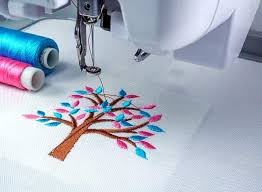
Tobe competent, theuser/individual onthejobmustbeableto:
PC1. Identifyandusematerialsrequiredbasedonthe specifications Embroidery Machine Operator Course.
PC2. Takethenecessaryactionwhenmaterialsdonotconformtoqualitystandards
PC3. Report and replace identified faulty materials and component parts which do notmeetspecification PC4. Identifymodifiabledefectsandreworkonthem
PC5. Carryoutworksafelyandataratewhichmaintainswork flow
PC6. Reporttotheresponsiblepersonwhentheworkflowofotherproduction areas disruptswork
PC7. Test,sort,trackfeedandexaminework in progress
PC8. Carryoutqualitychecksatspecifiedintervalsaccordingtoinstructions
PC9. Applythe allowed tolerances
PC10. Identifyfaultsandtakeappropriateactionfor rectification
PC11. Makeadjustmentspromptlyto ensure the embroidery work matches thespecification
PC12. Fault-findmaterials and componentsfor creased, stained, damage and incorrectlymade-upcomponent parts
PC13. Reportfaultsinotherprocessestotheappropriateperson
PC14. Maintaintherequiredproductivityandqualitylevels Embroidery Machine Operator Course.
PC15. Completeand maintain documentation
Maintainthe work area,toolsandm achiness Embroidery Machine Operator Course:-

Tobecompetent,theuser/individual onthejobmustbeableto:
PC1. Handle materials ,machinery ,equipment and tools safely and correctly
PC2. Usecorrectliftingandhandlingprocedures
PC3. Usematerialstominimizewaste
PC4. Maintainacleanandhazardfreeworkingarea
PC5. Maintaintoolsandequipment
PC6. Carryoutrunningmaintenancewithinagreedschedules
PC7. Carryoutmaintenanceand/orcleaningwithinone’sresponsibility
PC8. Reportunsafeequipmentandotherdangerousoccurrences
PC9. Ensure that the correct machine guards are in place
PC10. Workin a comfortable positionwiththecorrectposture Embroidery Machine Operator Course.
PC11. Use cleaning equipment and methods appropriate for the work to be carriedout
PC12. Disposeofwastesafelyinthedesignatedlocation
PC13. Storecleaningequipmentsafelyafter use
PC14. Carryoutcleaningaccordingtoschedulesandlimitsofresponsibility
Comply with health,safetyand security requirementsatwo rk:-
Tobe competent, theuser/individual onthejobmustbeableto:
PC1. Comply with health and safety related instructions applicable to the workplace
PC2. Useandmaintainpersonalprotectiveequipmentasperprotocol
PC3. Carryoutownactivitiesinlinewith approved guidelinesandprocedures
PC4. Maintainahealthylifestyleandguardagainstdependencyonintoxicants
PC5. Followenvironmentmanagementsystemrelated procedures
PC6. Identify and correct (impossible) malfunctions in machinery and equipment Embroidery Machine Operator Course.
PC7. Reportanyservicemalfunctionsthatcannotberectified
PC8. Store materials and equipment in line with manufacturer’s and organisational requirements
PC9. Safelyhandleandmovewasteanddebris
PC10. Minimize health and safety risks to self and others due to own actions
PC11. Seekclarifications,fromsupervisorsorotherauthorizedpersonnelincase of perceived risks
PC12. Monitor the work place and work processes for potential risks and threats
PC13. Carry out periodic walk-through to keep work area free from hazards and obstructions, if assigned
PC14. Report hazards and potential risks/ threats to supervisors or other authorized personnel
PC15. Participate in mock drills/ evacuation procedures organized at the workplace
PC16. Under take first aid ,fire-fighting and emergency response training ,if asked to doso
PC17. Take action based on instructions in the event of fire, emergencies or accidents
PC18. Follow organisationproceduresfor shutdown and evacuation when re
Guidelines for Assessment:-
- Criteria for assessment for each Qualification Pack will be created by the Sector Skill Council. Each Performance Criteria (PC) will be assigned marks proportional to its importance in NOS. SSC will also lay down proportion of marks for Theory and Skills Practical for each
PC 2. The assessment for the theory part will be based on knowledge bank of questions created by the
SSC 3. Individual assessment agencies will create unique question papers for theory part for each candidate at each examination/training center (as per assessment criteria below)
4. Individual assessment agencies will create unique evaluations for skill practical for every student at each examination/training center based on this criteria Embroidery Machine Operator Course.
5. To pass the Qualification Pack, every trainee should score a minimum of 70% in every NOS.
6. In case of successfully passing only certain number of NOS’s, the trainee is eligible to take subsequent assessment on the balance NOS’s to pass the Qualification Pack
(Carry out different types of embroidery stitches using an embroidery machine):-
PC1. Analyse & interpret the given design which embroidery needs to be embroidered & the type of embroidery
PC2. Check the materials required for embroidery with the given specifications
PC3. Setup the embroidery machine to the suited setting for carrying out the embroidery to be done
PC4. Use the embroidery machine to carry out dotted stitch on given fabric / material
PC5. Operate the embroidery machine to embroider different designs as per given pattern/art work such as variations of round leafs & pointed leafs Embroidery Machine Operator Course.
PC6. Embroider any given pattern on fabric using the correct thread & materials, using the embroidery machine.
PC7. Carry out appliqué work in machine embroidery & its variation
PC8. Carry out Dori work in machine embroidery as per given design/art work
PC9. Carry out mirror work through machine embroidery as per given design
PC10. Execute cut work through machine embroidery as per the given design
PC11. Carry out round stitch in machine embroidery
PC12. Conform to company quality standards
PC13. Check with in charge /others when unsure of new product details
PC14. Minimise and dispose the waste materials in the approved manner
PC15. Carry out Operations at a rate which maintains workflow
PC16. Respond appropriately if the embroidery do not meet product specification & take corrective action
(Embroider decorative designs embroidery machine):-
PC1. Make sure the work area is free from hazards using
PC2. Follow the instructions & design specifications given for the embroidery to be done
PC3. Ask questions to obtain more information on tasks when the instructions you have are unclear
PC4. Agree and review your agreed upon work targets with your supervisor and check for special instructions, if any
PC5. Use the correct tools and equipment’s
PC6. Check that equipment is safe and set up in readiness for use
PC7. Select the correct component parts/fabric/material for embroidery
PC8. Check that the materials to be used are free from faults
PC9. Ensure the materials used meet the specification matching
a. Embroidery Artwork
b.Design sample of the embroidered product
PC10. Carry out test sews
PC11. Check needles and threads regularly
PC12. Check if fabric / Component is correctly marked and pieces cut as required
PC13. Report faults in the materials
PC14. Conform to company quality standards
PC15. Report any damaged work to the responsible
PC16. Follow company reporting procedures about defective tools and machines which affect work and report risks/ problems likely to affect services to the relevant person promptly and accurately
PC17. Leave work area safe and secure when work is complete
PC18. Operate embroidery machines safely and in accordance with guidelines
PC19. Optimize the positioning and layout of materials to ensure a smooth and rapid throughput
PC20. Check the equipment prior to making the stitching, including correct controls, correct attachments, correct needle & thread
PC21. Ensure the embroidered design conforms to the artwork specifications National Occupational Standard

Carry out stitching activities using machine or by hand:-
B. Prepare for stitching operations The individual /user will be able to :
a. keep the work area free from hazards .
b. Follow the instructions as written on the work ticket/ job card in line with the responsibilities of respective job role and
c. Seek information on the tasks which are not clear simultaneously reviewing instructions with supervisor.
d. Check that equipment is safe and set up in readiness for use
e. Select the correct component parts for the style being worked on
f. check that the materials to be used are free from faults
g. Ensure the materials used meet the specification matching Within a product and Between a pair of products where applicable
h. Carry out test sews
i. Check needles, awls and threads regularly
j. check that the fabric and the component is correctly marked and the pieces are cut as per the requirement
. k. ensure the fabric pieces and linings are pinned or sewn together as required, and appropriately hung in readiness for assembly.
l. Conform to company quality standards and follow company reporting procedures about defective tools and machines which affect work and report risks/ problems likely to affect services to the relevant person promptly and accurately
B. The individual will develop the skill to stitch components to produce apparels by:-
a. carrying out work functions in line with the responsibilities of job role
b. Examining the specific item to identifying what type of stitching is best suited
c. Estimating the expected length of time for the process
d. Using the correct machine, tools (e.g.: attachments , threads , needles, awls, Scissors, Measuring tapes and rulers) and equipment
e. Setting up machine ((Apparel Sewing machine) according to manufacturers’ instructions and production requirements.
f. Setting machine controls for the materials being stitched
g. Handling materials, machinery, equipment and tools safely and correctly
h. Using correct lifting and handling procedures
i. cutting the thread appropriately
j. Threading the needle in the machine and adjust the needle as per the requirements
k. Performing a test run to ensure machine is operating correctly
l. Optimizing the positioning and layout of materials to ensure a smooth and rapid throughput m. Stitching the correct materials in the right sequence as required by the production specification
n. Ensuring stitched products meets specification in terms of labels and trimmings and conforms to the shape and size requirement
o. Inspecting stitched products against specifications and Identifying mark and place rejects in the designated locations
q. Carrying out alterations to meet customer requirements
r. Passing the stitched item to the next stage in the manufacturing process after validation
s. Responding accordingly where stitched items do not meet production specification
t. Seeking feedback from team mates on work
u. Sorting and placing work to assist the next stage of production and minimize the risk of damage
v. Leaving work area safe and secure when work is complete
w. Completing forms, records and other documentation
Contribute to achieve product quality in stitching operations:-
A. The individual will be able to achieve product quality in stitching Operations and will become proficient to:
a. Identify and use materials required based on the job card/ work ticket
b. Take the necessary action when materials do not conform to company quality standards
c. Report and replace identified faulty materials and component parts which do not meet specification
d. Identify modifiable defects and rework on them
e. Report to the responsible person when the work flow of other production areas disrupts work
f. Test, sort, track feed and examine work in progress
g. Carry out quality checks at specified intervals according to instructions
h. Apply the allowed tolerances
i. Identify faults in materials and components for crease, stains, damage etc. and incorrectly made-up component parts and take appropriate action for rectification
j. Make adjustments promptly to return product to specification
k. Maintain the required productivity and quality
Personal Attributes:-
The candidate should have aptitude for conducting training , pre /post work to ensure competent , employable candidates at the end of training. Strong communication skills, interpersonal skills, ability to work as team; diligent and is passionate for maintaining the quality in content and training delivery methodology. Candidate should have basic understanding of English language; however this should not be a restrictive criterion as long as the candidate is willing and open to learn. He/she must be able to speak, read and write in the local language.
(Carryout Stitching activities using machine or by hand):-
PC1. Make sure the work area is free from hazards
PC2. Follow the instructions on the work ticket/ job card in line with the responsibilities of respective job role
PC3. Ask questions to obtain more information on tasks when the instructions you have are unclear
PC4. Agree and review your agreed upon work targets with your supervisor and check for special instructions, if any
PC5. Use the correct tools and equipments
PC6. Check that equipment is safe and set up in readiness for use
PC7. Select the correct component parts for the style being worked on
PC8. Check that the materials to be used are free from faults
PC9. Ensure the materials used meet the specification matching

- Within a product
- b. Between a pair of products where applicable
PC10. Carry out test sews
PC11. Check needles, awls and threads Regularly
PC12. Check if fabric / Component is correctly marked and pieces cut as Required
PC13. Fabric pieces and linings are pinned or sewn together as required, and appropriately hung in readiness for Assembly
PC14. Report faults in the materials
PC15. Conform to company quality Standards
PC16. Report any damaged work to the responsible person
PC17. Follow company reporting procedures about defective tools and machines which affect work and report risks/ problems likely to affect services to the relevant person promptly and Accurately
PC18. Sort and place work to assist the next stage of production and minimise the risk of damage
PC19. Leave work area safe and secure when work is complete
PC20. Complete forms, records and other documentation
PC21. Examine the specific item to identify what type of stitching is best suited
PC22. Estimate the expected length of time for the process
PC23. Set up machine (Apparel Sewing machine) according to manufacturers’ instructions and production requirements
PC24. Set machine controls for the materials being stitched
PC25. Cut the thread appropriately
PC26. Thread the needle in the machine and adjust the needle as per the requirements
PC27. Perform a test run to ensure machine is operating correctly
PC28. Report defective machines, tools and/or equipment to the responsible person
PC29. Operate machines safely and in accordance with guidelines
PC30. Optimize the positioning and layout of materials to ensure a smooth and rapid throughput
PC31. Check the equipment prior to making the stitching, including:
- Correct controls
b) Correct attachments
c) Changing needles
d) Changing threads
e) Changing awls
f) Correct Timing
PC32. Stitch the correct materials in the right sequence as required by the production specification
PC33. Ensure stitched product conforms to shape and size requirement
PC34. Ensure stitched products meets specification in terms of labels and trimmings
PC35. Inspect stitched products against specifications
PC36. Identify mark and place rejects in the designated locations
PC37. Carry out alterations to meet customer requirements
PC37. Carry out alterations to meet customer requirements
PC38. Pass the stitched item to the next stage in the manufacturing process after validation
PC39. Respond accordingly where stitched items do not meet production specification
PC40. Minimize and dispose the waste materials in the approved Manner
PC41. Seek feedback from team mates on work related performance
PC42. Check with in charge /others when unsure of new product details
PC43. Clean and make safe machines after use
PC44. Carry out basic maintenance of own machines
PC45. Report risks/ problems likely to affect services to the relevant person promptly and accurately
PC46. Carry out Operations at a rate which maintains workflow and meets production targets
(Contribute to Achieve product quality in stitching operations):-
PC1. Identify and use materials required based on the job card/ work Ticket
PC2. Take the necessary action when materials do not conform to company quality standards
PC3. Report and replace identified faulty materials and component parts which do not meet specification
PC4. Identify modifiable defects and rework on them
PC5. Carry out work safely and at a rate which maintains work flow
PC6. Report to the responsible person when the work flow of other production areas disrupts work
PC7. Test, sort, track feed and examine work in progress
PC8. Carry out quality checks at specified intervals according to instructions
PC9. Apply the allowed tolerances
PC10. Identify faults and take appropriate action for rectification
PC11. Make adjustments promptly to return product to specification

